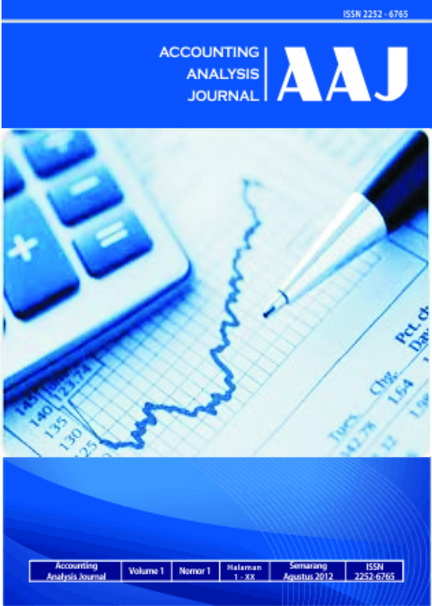PENGARUH INTELLECTUAL CAPITAL TERHADAP KINERJA KEUANGAN DAN NILAI PERUSAHAAN PERBANKAN INDONESIA
##plugins.themes.academic_pro.article.main##
Abstract
Penelitian ini dilakukan dengan tujuan untuk memperoleh bukti empiris terkait pengaruh intellectual capital (IC) baik perhitungan secara value added (VAICTM) maupun masing-masing komponen IC, yakni : capital employed efficiency (CEE), human capital efficiency (HCE) dan structural capital efficiency (SCE) terhadap kinerja keuangan (return on asset) dan nilai perusahaan (price book value) perbankan yang terdaftar di BEI di 2010-2013. Jumlah sampel yang diobservasi yaitu 118 dengan teknik pengambilan sampel menggunakan metode populasi dari 30 perusahaan perbankan. Teknik analisis yang digunakan adalah regresi linear berganda dengan menggunakan empat model regresi. Hasil penelitian menunjukkan bahwa modal intellectual capital (VAICTM) berpengaruh positif terhadap kinerja keuangan (ROA) dan nilai perusahaan (PBV). CEE berpengaruh positif terhadap kinerja keuangan, namun berpengaruh negatif terhadap nilai perusahaan, HCE terbukti berpengaruh positif baik terhadap kinerja keuangan maupun nilai perusahaan, dan SCE terbukti berpengaruh negatif baik terhadap kinerja keuangan dan begitu juga terhadap nilai perusahaan. Saran yang dapat diberikan dari adanya penelitian ini adalah sebaiknya perusaahaan perbankan dapat mengelola masing-masing indikator modal intelektual lebih baik agar dapat meningkatkan performa perusahaan.
The study is conducted with the purpose of acquiring empirical evidence related to the influence of intellectual capital (IC) in calculation of value added (VAICTM) and also each components of IC, there are capital employed efficiency (CEE), human capital efficiency (HCE) and structural capital efficiency (SCE) toward the financial performance (return on asset) and value of company (price book value). The sample in this research is 118 by using population method sampling of 30 banking companies. The technique analysis used is the multiple linear regression which used four models of regression. The research result showed that intellectual capital (VAICTM) has positive influence to the financial performance (ROA) and value of company (PBV). CEE has positive influence to the financial performance but negative influence to the value of company, HCE proven has positive influence to the financial performance and also to the value of company, and SCE proven has negative influence either to the financial performance or the value of company. Advice that can be given the presence of this research is the banking companies able to manage each components of intellectual capital better to improve the performance of company.
##plugins.themes.academic_pro.article.details##
References
Brennan, N. & Connel, B. (2000), “Intellectual Capital: Current Issues and Policy Implicationsâ€, Journal of Intellectual Capital, 1(3), pp. 206-240.
Chen, M., Cheng, S., & Hwang, Y. (2005). An empirical investigation of the relationshipbetween intellectual capital and firm's market value and financial performance. Journal of Intellectual Capital, 6(2).
Firer S., & Williams, M. (2003). Intellectual capital and traditional measures of corporate performance. Journal of Intellectual Capital, 4(3).
Ghozali, Imam. (2006). Aplikasi Analisis Multivariate dengan Program SPSS. Semarang: Badan Penerbit Universitas Diponegoro.
Ihyaul Ulum. (2008). “Intellectual Capital Dan KinerjaKeuangan Perusahaan; Suatu Analisis dengan Pendekatan Partial Least Squaresâ€.
Kamath, G. Barathi. (2007). The intellectual capital performance of Indian banking sector. Journal of Intellectual Capital, 8(1), pp. 96-123.
Ross, Westerfield & Jordan. (2008) Corporate Finance Fundamentals, New York, The McGraw-hill companies, Inc.
Sangkala. (2006). Intellectual Capital Management: Strategi Baru Membangun Daya Saing Perusahaan. Jakarta: Yapensi.
Setyarini Santoso (2012). “Pengaruh modal intelektual dan pengungkapannya terhadap kinerja perusahaan.†Jurnal Akuntansi dan Keuangan. 14(1).pp.16-51
Solikhah, Badingatus. (2010). “Pengaruh Intellectual Capital terhadap Kinerja Keuangan Perusahaan, Pertumbuhan dan Nilai Pasar pada Perusahaan yang Tercatat di Bursa Efek Indonesiaâ€. Tesis. Universitas Diponegoro. Semarang.
Stewart, Thomas A. (1997). Intellectual Capital: The Wealth of Organizations. Doubleday. PT. Elex Media Komputinto. Jakarta.
Yuniasih N. W., Wirama D. G. & Badera, I D. N. (2010). Eksplorasi Kinerja Pasar Perusahaan: Kajian Berdasarkan Modal Intelektual (Studi Empiris pada Perusahaan Keuangan Yang Terdaftar di Bursa Efek Indonesia). Simposium Nasional Akuntansi XIII Purwokerto.
Zeghal, D. & Maaloul, A. (2010), “Analyzing Value Added As an Indicator ofIntellectual Capital and Its Consequences on Company Performanceâ€, Journal of Intellectual Capital, Vol. 11 No. 1, pp. 39-60.
